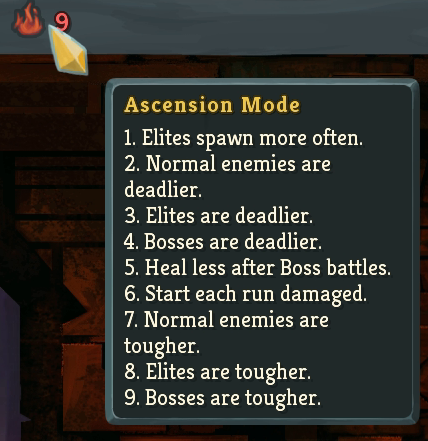
But you aren’t always so lucky, and the interesting and ever-changing challenge of Slay the Spire is how you adapt your strategy based on what cards are actually offered to you along the way.


It feels fantastic when you decide to lean into a certain style and manage to find all of the combo pieces you were hoping for, tearing through enemies with synergies that were specifically designed for each other.
#ASCENSION SLAY THE SPIRE FREE#
For example, the Silent can pick up attacks that stack a poison effect on enemies which you can then multiply or burst with rarer cards, but its card pool also supports a deck built around generating tons of free Shiv attack cards and then buffing them with other effects. While the available characters roughly conform to some general RPG archetype – the Ironclad is the warrior, the Silent is the rogue, and the Defect is kind of like a mage with a bio-mechanical twist – they each have multiple viable play styles you can try to build your deck around. But the simple animations for playing cards are still satisfyingly snappy, and I could take some turns lightning-fast once I got more comfortable. Taking as much pressure-free time as I needed was helpful early on, and pulling up the deck or discard screens even conveniently pauses the action during your opponent's turn. Slay the Spire doesn’t rush you with a timer as you make those tough calls either, so my confidence actually grew from every failed run since. Those little decisions are deceptively important, and there’s rarely an objectively “right” choice, which leaves lots of room to find your personal play style. Knowing when you can afford to take a few points of damage to inflict a few more of your own isn’t a huge deal in the heat of a battle, but it can make the difference in the long run as the Spire wears you down. It can be as simple as when you choose to play an attack card or a defense card. Slay the Spire has an addictive loop of experimenting, dying, and growing for the next run. You just get smarter and better at quickly deciding what will or won’t be useful, and the experimentation is one of my favorite parts. Apart from unlocking a few new cards and collectible Relics as you play, you never actually get stronger from one run to another. Being a roguelike, a run in which you make it all the way to the top only takes about an hour, giving Slay the Spire an addictive loop of picking cards, figuring out how good they are, dying frequently, and then taking that hard-earned knowledge with you into the next run.


 0 kommentar(er)
0 kommentar(er)
